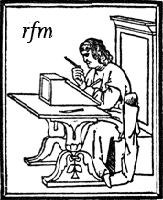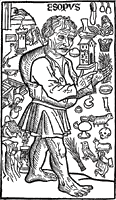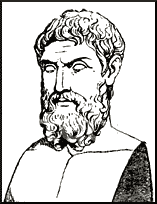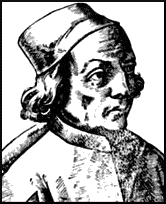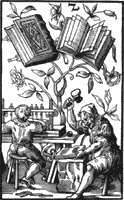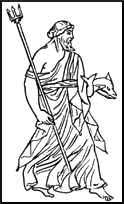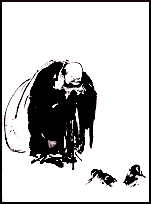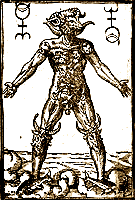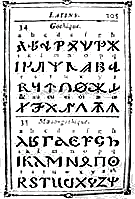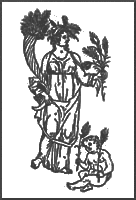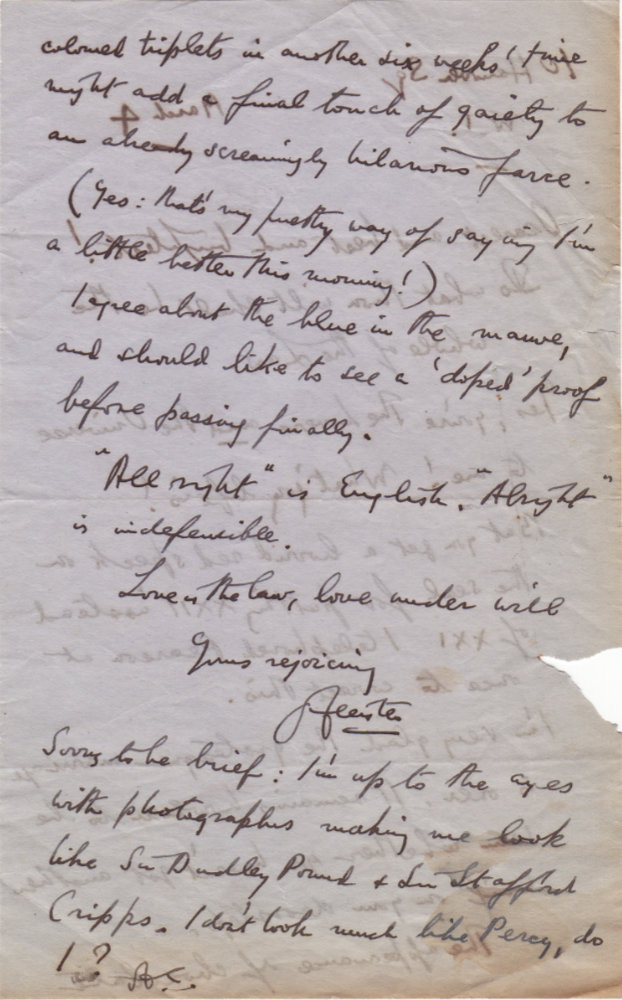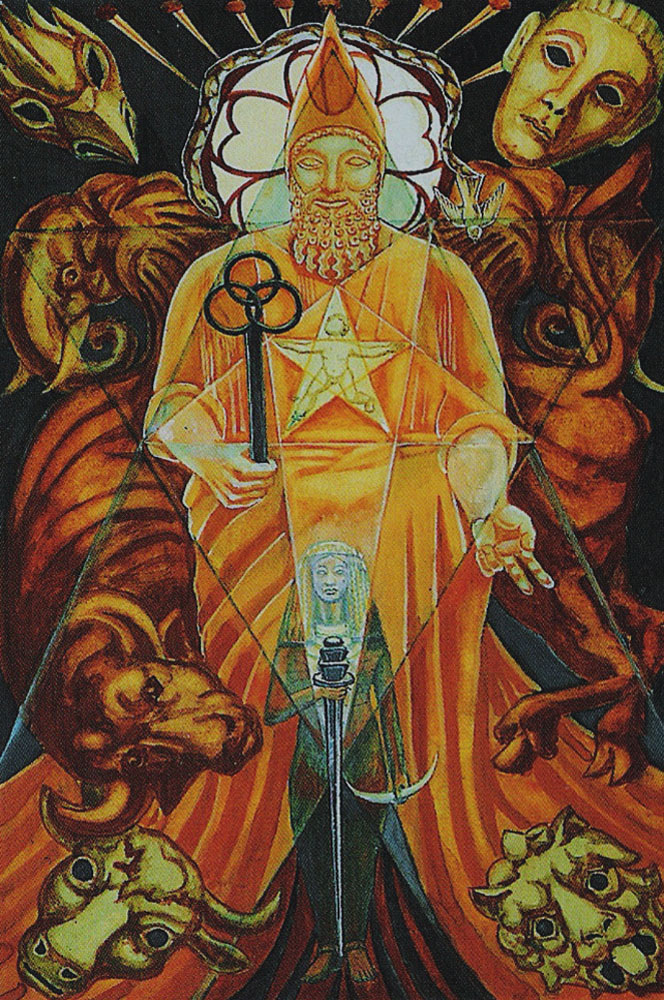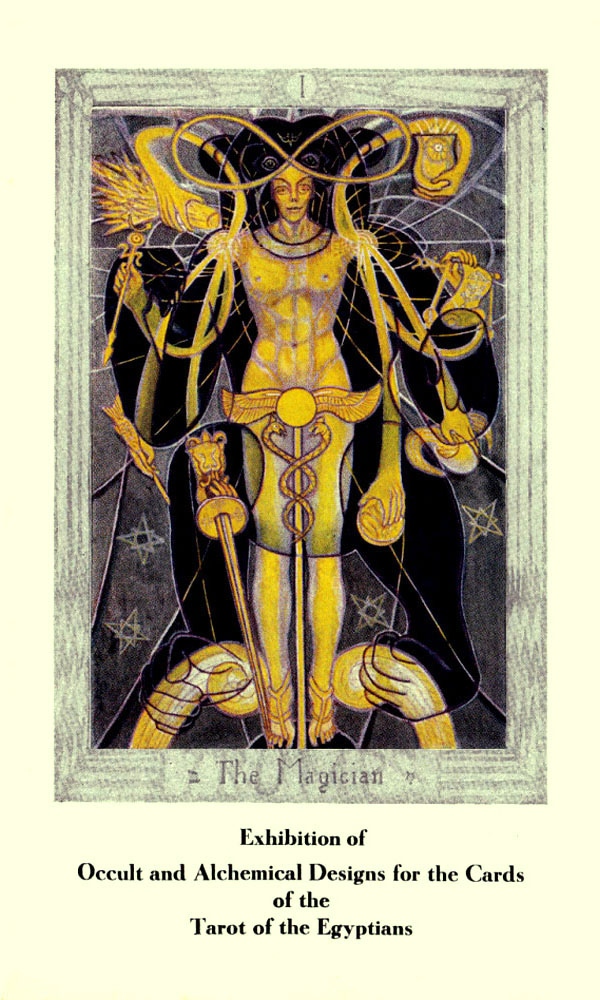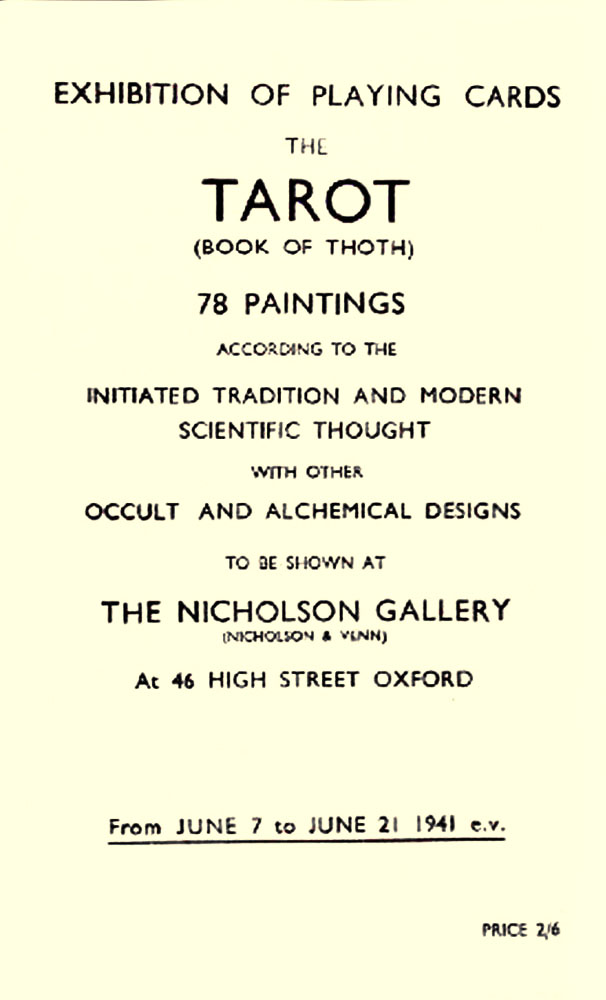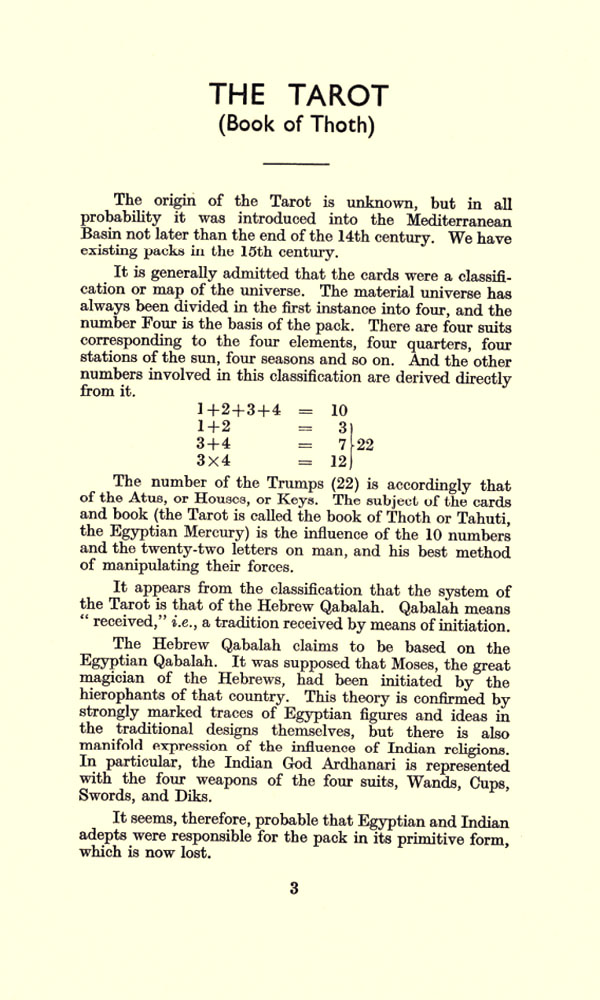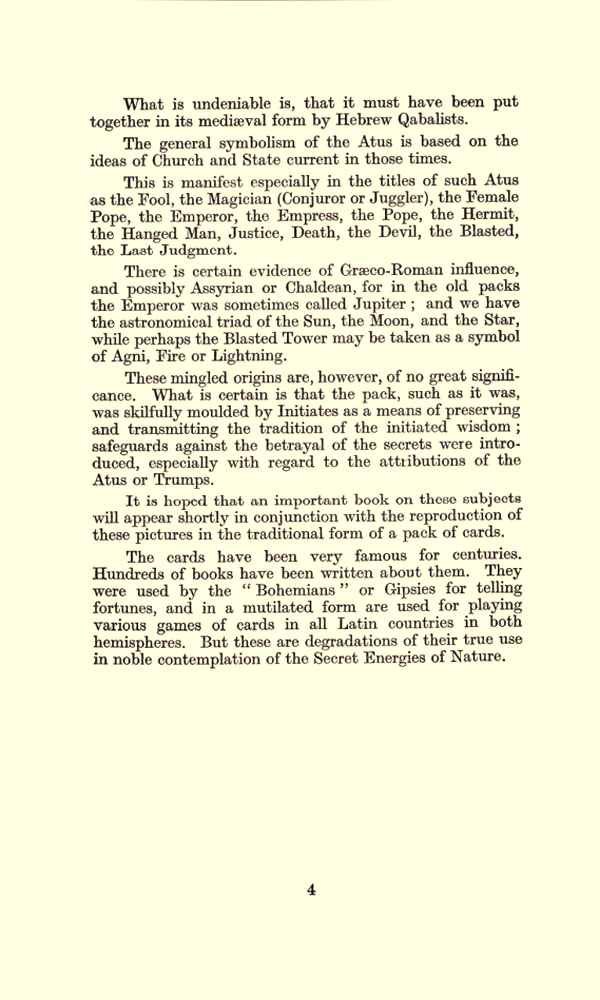Aleister Crowley & Frieda Harris: The Book of Thoth. A Short Essay on the Tarot of the Egyptians
Crowley/Harris The Book of Thoth
A book in every way as important as Magick or The Book of the Law
Aleister Crowley, Pseudonym: The Master Therion:
THE BOOK | OF | THOTH | A SHORT ESSAY ON THE TAROT | OF THE EGYPTIANS | BEING | THE EQUINOX VOLUME III No. V | by | THE MASTER THERION. | Artist Executant: FRIEDA HARRIS.
London: Chiswick Press for O.T.O., 1944 / York, Maine: Samuel Weiser, 2007.
Large octavo. ca. 252 × 189 mm. [2 blank], frontispiece, xii, 287, [2], [3 blank] pp. With eight tipped-in colour plates, and twenty collotype b/w plates depicting the Trumps, Court Cards, and Small Cards.
Original brown half morocco, five raised bands, spine gilt with title, Crowley’s Egyptian seal and OTO lamen; fore-edge and lower edge uncut. Covers decorated with a facsimile of the Egyptian design of the coloured paper of the 1944 edition.
Crowley’s last and best book. This second issue of the first edition is limited to eleven copies, printed by the Chiswick Press upon “Unbleached Arnold”, each of which is accompanied by an original autograph letter, signed, from Aleister Crowley to the ‘artist executant’ of the book, Lady Harris.
¶ The first edition of “The Book of Thoth” was published in 1944 in an edition of 200 signed and numbered copies. In 2007 a crate containing eleven sets of unbound, unsigned and unnumbered copies of this original edition was found in the estate of a friend of Crowley’s: Edward Noel FitzGerald. These sheets formed the basis for the present ‘issue’. Each of the eleven copies has been bound by an American master bookbinder in a facsimile of the original half-leather binding with papered boards with Egyptian motif. Great effort has been taken to match the original materials and style as closely as possible, leather was sourced from a supplier in England, the Egyptian-patterned paper and color plates were specially commissioned from a craftsman printer, and even the original dies were unearthed and used to stamp the gold OTO lamen and Crowley’s seal of Ankh-f-n-khonsu on the spine.
¶ Included is an original handwritten letter by Crowley, signed ‘Aleister’, to Frieda Harris, dated March 4 (1941), written on both sides of a sheet of greyish blue notepaper, 202 × 126 mm, at begin and end with the Thelemic greetings written in full.
¶ With a bookplate mounted on the front pastedown, stating the limitation and provenance of the second issue, and a four-page booklet, printed on the same paper as the book itself, outlining the history of the volume.
¶ “... a book in every way as important as Magick or The Book of the Law” (d’Arch Smith, p. 34).
First edition, second issue. Cf. Yorke 63,C.5 – Fuller p. 19 – Parfitt/Drylie 147 – d’Arch Smith p. 34 – Personalbibliographien.
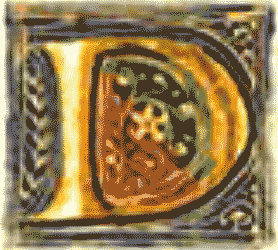 ie schönsten, in sich stimmigsten Tarotkarten. Hätte Crowley den Sand verschiedener Wüstenreligionen früher abgeschüttelt, wäre ihm mehr desgleichen gelungen. Die dritte Abbildung zeigt die Karte auf dem Frontispiz ohne den Rand, sie ist bearbeitet, um Mängel des damaligen Scans auszugleichen.
ie schönsten, in sich stimmigsten Tarotkarten. Hätte Crowley den Sand verschiedener Wüstenreligionen früher abgeschüttelt, wäre ihm mehr desgleichen gelungen. Die dritte Abbildung zeigt die Karte auf dem Frontispiz ohne den Rand, sie ist bearbeitet, um Mängel des damaligen Scans auszugleichen.
“She [Marguerite Frieda Harris] devoted her genius to the Work. With incredible rapidity she picked up the rhythm, and with inexhaustible patience submitted to the correction of the fanatical slave-driver that she had invoked, often painting the same card as many as eight times until it measured up to his Vanadium Steel yardstick!” (Introduction)
0. The Fool. Summary
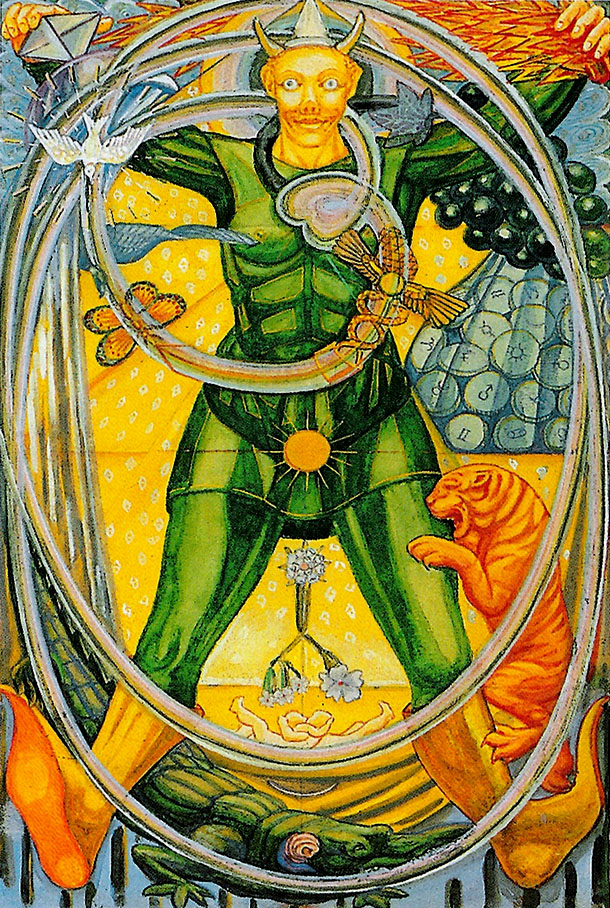
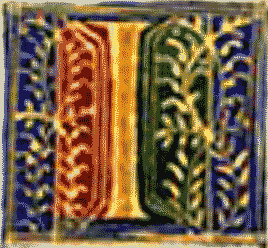 t has seemed convenient to deal separately with these main forms of the idea of the Fool, but no attempt has been made, or should be made, to prevent the legends overlapping and coalescing. The variations of expression, even when contradictory in appearance, should lead to an intuitive apprehension of the symbol by a sublimation and transcendance of the intellectual. All these symbols of the Trumps ultimately exist in a region beyond reason and above it. The study of these cards has for its most important aim the training of the mind to think clearly and coherently in this exalted manner.
t has seemed convenient to deal separately with these main forms of the idea of the Fool, but no attempt has been made, or should be made, to prevent the legends overlapping and coalescing. The variations of expression, even when contradictory in appearance, should lead to an intuitive apprehension of the symbol by a sublimation and transcendance of the intellectual. All these symbols of the Trumps ultimately exist in a region beyond reason and above it. The study of these cards has for its most important aim the training of the mind to think clearly and coherently in this exalted manner.
This has always been characteristic of the methods of Initiation as understood by the hierophants.
In the confused, dogmatic period of Victorian materialisation, it was necessary for science to discredit all attempts to transcend the rationalist mode of approach to reality; yet it was the progress of science itself that has reintegrated these differentials. From the very beginning of the present century, the practical science of the mechanician and the engineer has been forced further and further towards finding its theoretical justification in mathematical physics.
Mathematics has always been the most severe, abstract, and logical of the sciences. Yet even in comparatively early schoolboy mathematics, cognisance must be taken of the unreal and the irrational. Surds and infinite series are the very root forms of advanced mathematical thought. The apotheosis of mathematical physics is now the admission of failure to find reality in any single intelligible idea. The modern reply to the question “What is anything?” is that it is in relation to a chain of ten ideas, any one of which can only be interpreted in terms of the rest. The Gnostics would undoubtedly have called this a “chain of ten aeons”. These ten ideas must by no means be considered as aspects of some reality in the background. As the supposed straight line which was the framework of calculation has turned out to be a curve, so has the point which had always been taken as the type of existence, become the ring.
It is impossible to doubt that there is here a continually closer approximation of the profane science of the outer world to the sacred wisdom of the Initiate.
🞯 🞯 🞯 🞯 🞯
The design of the present card resumes the principal ideas of the above essays. The Fool is of the gold of air. He has the horns of Dionysus Zagreus, and between them is the phallic cone of white light representing the influence from the Crown [Kether: see the position of the Path of Aleph on the Tree of Life.] upon him. He is shown against the background of air, dawning from space; and his attitude is that of one bursting unexpectedly upon the world.
He is clad in green, according to the tradition of Spring; but his shoes are of the phallic gold of the sun.
In his right hand he bears the wand, tipped with a pyramid of white, of the All-Father. In his left hand he bears the flaming pine-cone, of similar significance, but more definitely indicating vegetable growth; and from his left shoulder hangs a bunch of purple grapes. Grapes represent fertility, sweetness, and the basis of ecstasy. This ecstasy is shown by the stem of the grapes developing into rainbow-hued spirals. The Form of the Universe. This suggests the Threefold Veil of the Negative manifesting, by his intervention, in divided light. Upon this spiral whorl are other attributions of godhead; the vulture of Maut, the dove of Venus (Isis or Mary), and the ivy sacred to his devotees. There is also the butterfly of many-coloured air and the winged globe with its twin serpents, a symbol which is echoed and fortified by the twin infants embracing on the middle spiral. Above them hangs the benediction of three flowers in one. Fawning upon him is the tiger; and beneath his feet in the Nile with its lotus stems crouches the crocodile. Resuming all his many forms and many-coloured images in the centre of the figure, the focus of the microcosm is the radiant sun. The whole picture is a glyph of the creative light.
Marguerite Frieda Harris
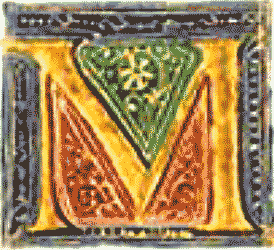 arguerite Frieda Bloxam, geboren am 13. August 1877 in London als Tochter des Chirurgen John Astley Bloxam (1843-1926), heiratete im April 1901 den liberalen Politiker Percy Alfred Harris (6. März 1876 – 28. Juni 1952), der 1932 zum Baronet geadelt wurde, nach dessen Tod zog sie nach Indien, wo sie in einem Hausboot lebte und sich dem Hinduismus widmete. Sie starb am 11. Mai 1962 zu Srinagar.
arguerite Frieda Bloxam, geboren am 13. August 1877 in London als Tochter des Chirurgen John Astley Bloxam (1843-1926), heiratete im April 1901 den liberalen Politiker Percy Alfred Harris (6. März 1876 – 28. Juni 1952), der 1932 zum Baronet geadelt wurde, nach dessen Tod zog sie nach Indien, wo sie in einem Hausboot lebte und sich dem Hinduismus widmete. Sie starb am 11. Mai 1962 zu Srinagar.
“My wife is an artist and a good one. She takes her art seriously, in fact works at her painting seven days a week and generally twelve hours out of the twenty-four. She has had an immense output of pictures.” (Percy Harris: Forty Years in and Out Parliament. London: Melrose, 1946. p. 192) Sie illustrierte ihre Bücher wie „Winchelsea: A Legend“, 1926, und einige ihrer Werke wurden 1942 auf einer Ausstellung zur phantastischen Kunst in den Leicester Galleries gezeigt. Anfangs stellte sie bisweilen unter dem Pseudonym „Jesus Chutney“ aus, um nicht nach ihrem Adel, sondern nach ihrem künstlerischen Können beurteilt zu werden. Harris war ein Co-Freimaurer und schuf eine Reihe von Arbeitstafeln für die ersten drei Grade, welche heute in einer Privatsammlung aufbewahrt werden. Sie erscheint als eine spirituelle Sucherin, die eine Reihe von Glaubensüberzeugungen in ihrem Leben angenommen hat. Ihr Sohn Jack erinnert sich aus Kindertagen an die Lehren von Mary Baker Eddy (1821–1910). Um 1937 oder 1938 studierte sie Anthroposophie und synthetische projektive Geometrie im Rudolf-Steiner-Haus bei George Adams von Kaufmann (1894–1963) und Olive Whicher (1910–2006).
Aleister Crowley lernte sie am 8. Juni 1937 im Royal Automobile Club durch ihren gemeinsamen Freund, den Schriftsteller Clifford Bax (1886–1962), kennen, zwei Jahre später begann bereits die Tätigkeit am Tarot; sie hatte einige seiner Bücher gelesen sowie sich mit dem I Ging beschäftigt. Ein knappes Jahr später wurde sie seine Schülerin und zahlte am 11. Mai 1938 £ 10.10.0 für die Zugehörigkeit zum Orden O.T.O. Dies weist darauf hin, daß Crowley ihre Co-Freimaurer-Grade als gleichwertig mit denen des O.T.O. anerkannte und ihr den entsprechenden O.T.O.-Grad verlieh, ohne daß sie sich zuvor den dazugehörigen Zeremonien unterziehen mußte. Als ihr Motto im A∴ A∴ wählte sie צָבָא (ṣāva, 93), ‚Heer, Kriegsmacht‘; ein Begriff, dessen Pluralform צְבָאוֹתּ (ṣevāʾot) Zebaoth ist.
Zuerst schuf sie Bilder für mehrere von Crowleys Büchern, darunter den „Baum des Lebens“ auf dem Schutzumschlag von „Little Essays toward Truth“, 1938; das Siegel für das Cover von „Thumbs Up!“, 1941; Crowleys Porträt auf dem Umschlag von „Olla: An Anthology of Sixty Years of Song“, 1946; Umschlag und Frontispiz für Crowleys Bestattungsprogramm, „The Last Ritual“, 1948; und den Einband für „Liber Aleph. The Book of Wisdom or Folly“, 1962, das sich zum Zeitpunkt von Crowleys Tod 1947 im Druck befand, aber erst fünfzehn Jahre später veröffentlicht wurde.
Anfang Mai 1938 lieh Crowley ihr ein Exemplar von „The Equinox“ I, 8, das „A Description of the Cards of the Tarot“ enthält. Harris schlug vor, daß sie zusammen ein Deck nach diesen Kriterien erstellen sollten. Ursprünglich veranschlagten sie sechs Monate für den Abschluß dieses Projektes, stellten jedoch bald fest, daß die Beschreibungen der Karten unzureichend waren, und Harris ermutigte ihn, ein eigenes Kartenspiel basierend auf seinen Kenntnissen in vergleichender Religionswissenschaft, Physik, Philosophie und Magie zu entwerfen. Durch ihren Einfluß wurden die Tarotkarten nicht traditionell, wie eigentlich von Crowley beabsichtigt, sondern Ausdruck ihrer beider okkulten, magischen, spirituellen wie wissenschaftlichen Ansichten. Sie trafen sich zu Besprechungen, arbeiteten jedoch getrennt, Crowley sandte Beschreibungen und Skizzen der Karten, Harris ihre Gemälde. Bisweilen genügten eine oder zwei Überarbeitungen, aber beim Magus waren z. B. mehr vonnöten, acht. Nach fünf Jahren Arbeit über Details von Bildern, Aussageweisen und entsprechenden Farbskalen wurde das Thoth-Tarot fertiggestellt.
Trotz einiger Pläne, ein mehrfarbiges Kartendeck zu produzieren, wurde keines zu ihrer beider Lebenszeit hergestellt. Nach Crowleys Tod verteidigte Harris das gemeinsame Erbe vor minderwertigen Reproduktionen und warnte z. B. Llewellyn Publications davor, ein Deck zu erstellen, das von den Schwarzweißtafeln in „The Book of Thoth“ eingefärbt wurde. [Die Bilder einer solcher frühen Ausgaben werden unten abgebildet.]
Ausstellungen
 ie letzten vier der obigen Abbildungen zeigen die ersten Seiten des Kataloges der ersten Ausstellung in der Nicholson Gallery, Oxford, Juni 1941. Die folgenden sieben Seiten bieten Beschreibungen der Trümpfe, hier wiedergegeben ohne die zahlreichen Schriftauszeichnungen in Kursiv:
ie letzten vier der obigen Abbildungen zeigen die ersten Seiten des Kataloges der ersten Ausstellung in der Nicholson Gallery, Oxford, Juni 1941. Die folgenden sieben Seiten bieten Beschreibungen der Trümpfe, hier wiedergegeben ohne die zahlreichen Schriftauszeichnungen in Kursiv:
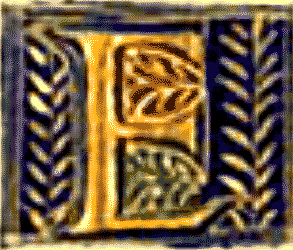 ine zweite Ausstellung fand Juli 1942 in den Berkeley Galleries von William Ohly statt: Exhibition of the 78 paintings of the Tarot Cards by Frieda Harris, einen Monat später neueröffnet in den Räumen der Royal Watercolour Society. Der Katalogtext ist von dem der ersten verschieden, auf der letzten Seite wird vermerkt: »The symbolism, traditional postures, attribution of the Cards, and the planetary, zodiacal and elemental colours have been given to me by an expert who has studied the Tarot for forty years and to whom my thanks are due for his courteous co-operation.«
ine zweite Ausstellung fand Juli 1942 in den Berkeley Galleries von William Ohly statt: Exhibition of the 78 paintings of the Tarot Cards by Frieda Harris, einen Monat später neueröffnet in den Räumen der Royal Watercolour Society. Der Katalogtext ist von dem der ersten verschieden, auf der letzten Seite wird vermerkt: »The symbolism, traditional postures, attribution of the Cards, and the planetary, zodiacal and elemental colours have been given to me by an expert who has studied the Tarot for forty years and to whom my thanks are due for his courteous co-operation.«
0 The Fool 1 The Magician 2 The Priestess 3 The Empress 4 The Emperor 5 The Hierophant 6 The Lovers 7 The Chariot 8 Adjustment 9 The Hermit 10 Fortune 11 Lust 12 The Hanged Man 13 Death 14 Art 15 The Devil 16 The Tower 17 The Star 18 The Moon 19 The Sun 20 The Aeon, 21 The Universe
0 The Fool
0 The Fool. Air. Aleph
The Fool is Air or Vacuum or Puissant Innocence. He holds the male element of fire, the female element of water, the sword of air, and the disc of earth. He is the Green Man of Spring, the great Fool of the Celts, Daluah and Parsifal. He is also Zeus Arrhenothelus, Dionysus Zagreus, Bacchus Diphues and Baphomet.
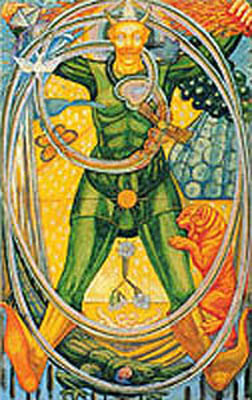
The Fool is Air, Emptiness, also Potential Purity. He holds the Wand of Fire, the Cup of Water, the Sword of Air, and the bag of planetary Disks. Round him is the rainbow issuing from and returning to his heart, he wears the fool’s cap, the horns of Bacchus, he stands on Harpocrates, the Egyptian symbol of adolescent Fertility, he is unconscious of the tiger tearing at his side, he is the Green Man of the Celts, Daluah and Parsival. 'This is the moment of divine consciousness.
I The Magician or Juggler
I The Magician or Juggler. Mercury. Beth
Mercury, who is Wisdom, Will and Word, by whom the world is created, symbolises the fluidic basis of all transmission of activity. Behind him and through him is the Ape, Hanuman, which is a Hindu conception. The Egyptian counterpart, Thoth, is also always followed by the Cynocephalus Ape.
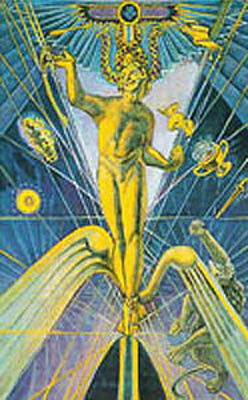
He is Mercury, the messenger of God, and juggles with the four symbols of the Elements, and the papyrus or Word, the pen or Will, the wand or Wisdom. He represents the creative force in action. As Thoth in Egyptian tradition, his attendant and shadow is the Cynocephalus Ape.
II The Priestess
II The Priestess. The Moon. Gimmel
She is Isis, the eternal virgin, and again she is Artemis. It is for this reason she is clothed in the luminous veil of light, light being viewed not as the manifestation, but as the veil, of the spirit.
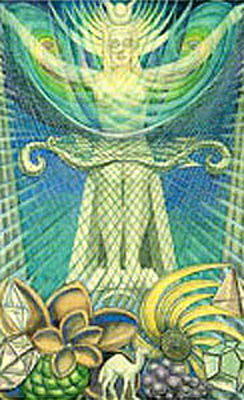
She is a spiritual Isis and a virgin Artemis. With her veil of light, she is weaving the crystals and fruits of the Earth. She carries the huntress’s bow and the musical sistrum.
III The Empress
III The Empress. Venus. Daleth
She is seated in traditional posture. This posture represents salt, the inactive principle of nature. The lotus typifies the feminine or passive power. The Bees on the robe may be compared with the Fleur de Lys, suggesting the French origin of the symbol; the belt is the Zodiac. The Pelican may be identified with the Great Mother and her offspring. It represents the continuity of life and inheritance of blood uniting all forms of nature. The White Eagle typifies Alchemical Salt, and the White Tincture, of the nature of silver.
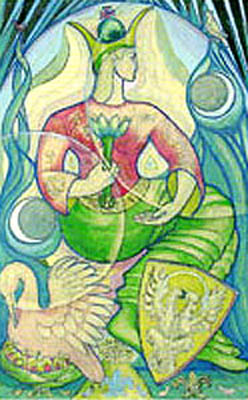
The Empress is seated in the traditional posture symbolising alchemical Salt. This is woman in her all-embracing receptivity, incarnate womanhood, holding the lotus, wearing the belt of the Zodiac, surrounded by her Venus birds, the pelican of self-surrender and the heraldic white eagle of salt.
IV The Emperor
IV The Emperor. Aries. Tzaddi
This card means Government by means of two contrasting symbols. These are the Ram, which, when wild, is solitary and courageous, and the Lamb, which is docile and cowardly, and is, in fact, the Ram tamed by authority. The posture typifies the Alchemical Sulphur, the fiery element of the universe. The Red Eagle represents the Red Tincture of the Alchemists, which is of the nature of gold.
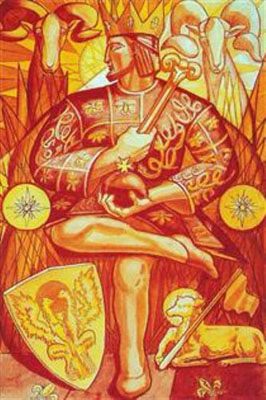
Again he is seated according to tradition. His legs form a right angle, typifying rule through unyielding law and order. The goats behind him show he is governed by Aries, creative dominating force. The bees on his costume may have originated from French tradition, but more probably they typify the bees of the Secret Doctrines in the Indian Upanishads. The heraldic red eagle is the fiery sulphur of Alchemy. The lamb is, possibly, a reminiscence of the Knights Templar.
V The Hierophant
V The Hierophant. Taurus. Vau
The reference in this card is to Taurus the Bull and its Indian equivalent, the Elephant. The pentagram with its dancing male child symbolises the New Aeon of the child Horus, which takes the place of the Old Aeon that has governed us for 2,000 years. The Hierophant moves only at intervals of 2,000 years. The four masks are the guardians of every mystery, culminating in the Grand Mystery of the uniting of microcosm and macrocosm. The woman before the hierophant represents Venus, now armed and militant. The Wand with its interlaced rings shows the three Aeons of Isis, Osiris and Horus.
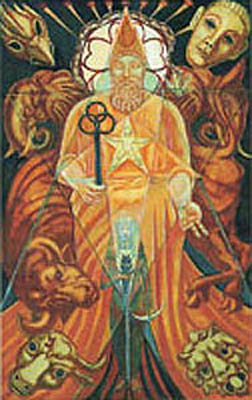
The Hierophant is seated on his governing sign Taurus, the elephants are the Indian form of the same. The pentagram with a point upwards and the dancing child shows that he has the heart of a child; in the reversed pentagram the meaning seems to suggest he has dominion through will; the final pentagram again points upwards, showing his acceptance of a governing cosmic law. The four masks are the Cherubim, man, eagle, lion and bull. His votary, the woman, stands with her sword pointing downwards signifying, perhaps, that woman in the future will draw fresh wisdom by the use of her subconscious.
VI The Lovers
VI The Lovers. Gemini. Zain
This specifically alchemical card is a symbol of procreation, the swords drawing attention to the process of division which actually takes place. Cain and Abel represent the refusal of God to hear the children of Eve until blood is shed. This seems to be the symbolisation of external religion. It was by means of the shedding of blood and of external religions that Cain was able to have contact with his fellow men. In that sense the meaning of the card is the giving of science to mankind, since the murder symbolises analysis and the subsequent contact, synthesis.
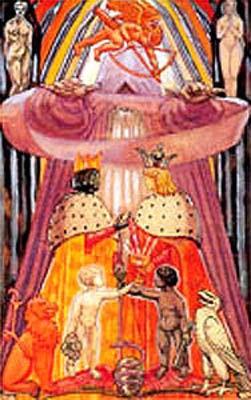
This is an alchemical card illustrating the marriage or union of two opposites, thus we have the prince and princess holding the wand and the cup, Cain and Abel, Lilith and Eve. The swords at the back suggest the intellectual process in the uniting of two elements. The figure of the Creator blesses this deliberate synthesis. The alchemical white eagle of salt and the red eagle of sulphur, the Egg of wisdom and the winged wand of Osiris are at the bottom of the card.
VII The Chariot
VII The Chariot. Cancer. Cheth
The four Sphinxes on this card, drawing the chariot, are the Bull, the Lion, the Eagle, and the Man, the whole representing the sixteen sub-elements. The function of the Charioteer is to bear the Holy Grail, in the centre of which is radiant blood, symbolising the presence of Light in Darkness.
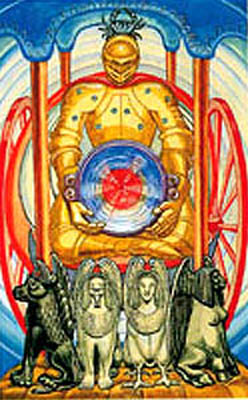
Held by the charioteer is the Cup of Indian, Egyptian and Arthurian tradition and it contains the blood of voluntary sacrifice. The charioteer (spirit) is seated in the chariot of the body and is drawn by sphinxes, who represent the sixteen sub-elements of the emotions.
VIII Adjustment
VIII Adjustment. Libra. Teth
Or traditionally Justice. This card represents the Woman satisfied. This condition is symbolised by the scales, in which she weighs the universe; Alpha, the first, exactly balances against Omega, the last. These scales represent the two ‘witnesses.’ Each ‘witness’ is an authentic manifestation of Maya, the one fulfilling the other by a process of contradiction, for nature is not Justice — she is rather through her process of equilibrium “la Justesse.” Finally, this Woman is the original Harlequin, for the wild blend of colour and of movement resolves itself into an equilibrium of all possibilities of sensation.
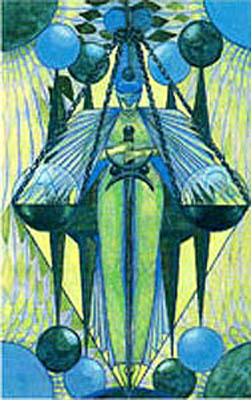
Traditionally called Justice, the new name is a literal translation of the French “Justesse,” that is Equilibrium. She is balancing from the headdress of Isis the scales in which are the bubbles of Maya, illusion, typifying the transitory quality of human justice. The whole picture represents balance by opposites. The diamond patterning foreshadows the balancing Harlequin of the Commedia del l’Arte.
IX The Hermit
IX The Hermit. Virgo. Yod
The letter, to which this card is attributed, is the letter Yod, the foundation of all the other letters of the Hebrew Alphabet. The symbolism is that of the Creator of Life and his representative is the Spermatozoon. For that reason the card is called the Hermit. In the same order of ideas the Hermit holds the lamp whose centre is the Sun. The Egg, surrounded by the coils of a snake, typifies the Universe, while the snake signifies the fluidic essence of light, which is the life of the Universe. In this card are traces of the legend of Persephone. The serpent Wand, here seen growing out of the Abyss, is the Wand of Mercury, the guide of the soul through the lower regions. The letter Yod means “a hand,” and the hand is the centre of the design.
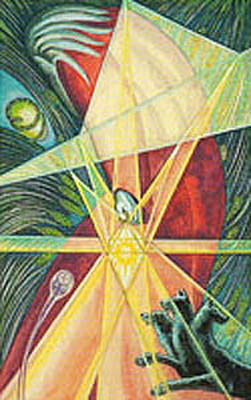
Here we have, in the hand of the Hermit, the Lamp or Sacred Wisdom. It contains the Sun which is hidden beneath the surrounding darkness to fructify the earth. The Hermit is looking at the Egg (Universe) which is surrounded by the snake, a symbol of life. The hounds of hell endeavour to snatch the sacred light and the little Homunculus. The wheat is in the masonic tradition.
X Fortune
X Fortune: Jupiter. Kaph
By the attribution of this card to the planet Jupiter, it is made to represent the Universe in its aspect of continual change. The appearance of all sorts of celestial phenomena emphasises this. In the middle is the ten-spoked wheel, the accepted symbol of Fortune. The three figures attached to the wheel symbolise the three forms of energy, expressed in the Hindu System by the term Guna. At the top sits the Sphinx, typifying intelligence and balance (Sattvas); Hermanubis, in the semblance of an ape, represents the restlessness of brilliant, unstable reason (Rajas); and at the bottom, almost falling from the wheel, is the reptile-headed Typhon (Tamas), the symbol of destruction, sluggishness, and ignorance. The alchemical attributes of the Gunas are Sulphur, Mercury, and Salt.
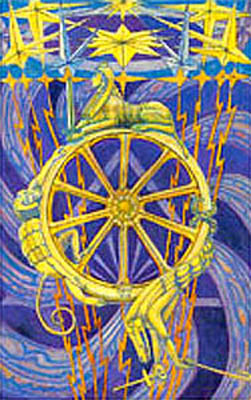
On the Wheel of Fortune at the top is the Sphinx meaning intelligence and balance (Hindoo=Sattvas). On the left is Hermanubis the Ape who is unstable brilliant reason (Hindoo=Rajas). At the bottom of the wheel is Typhon who expresses ignorance and sluggishness (Hindoo=Tamas). Here we have the implication to be found on all these cards of possible regeneration in all circumstances, for Typhon holds the Ankh of salvation with one hand and in the other the hook with which he snatches the soul. The eclipse of stars at the top of the card generates in forked lines the circle of the wheel.
XI Lust
XI Lust. Leo. Teth
This card was formally called Strength. It implies, however, not only strength, but joy in strength exercised. The seven heads of the lion are, respectively, that of an angel, saint, poet, adulteress, warrior, satyr, and lion-serpent. The central figure is the woman, who has surrendered herself to all the forces of creation and who rides astride of the Beast. In her left hand she holds the reins, as representing the passion which unites them, and in her right she holds aloft the Cup aflame with love and death. In this Cup are mingled the elements of the sacrament of the Aeon. In the background are the bloodless figures of the saints on whom this mirage travails, for their whole life has been absorbed into the Holy Grail.
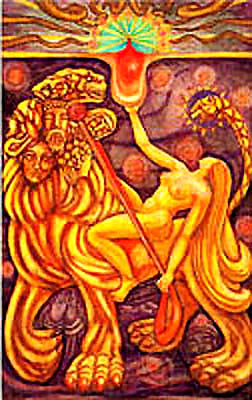
This card was called Strength. It means joy in desire. The lion has seven heads, an angel, a saint, a poet, a warrior, a bacchante, a satyr and a lion-serpent. The woman has given herself to the forces of life. She holds the Cup or impregnated womb. The horns surrounding it represent the male element. The figures under the feet of the lion are the martyrs to whom this path towards Union is an empty dream. The reins which are held by the woman are the passion which unites her to the Beast.
XII The Hanged Man
XII The Hanged Man or Dying God. Water. Mem
or Dying God. The posture of the drowned or hanged man is of the greatest significance. The legs are crossed so that the right leg forms a right angle with the left leg, and the arms are stretched out at an angle of sixty degrees, so as to form an equilateral triangle. This gives the symbol of the triangle surmounted by a cross, which represents the descent of the light into darkness in order to redeem it. The whole idea of sacrifice is a misconception of nature, and the element of water to which the card is attributed is the element of illusion.
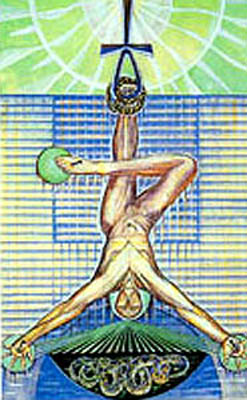
This figure is Osiris or Christ and shows redemption through suffering. He is drowned in the waters of affliction, the attitude is traditional and involves a right angle and a triangle. His foot is bound to the Ankh of Immortality by the serpent of life. The complete symbol is a triangle and a cross.
XIII Death
XIII Death. Scorpio. Nun
The alchemical sense of Death is not so much destruction as change. Thus we have, in this card, the Scorpion, representing primitive energy always ready to commit suicide (according to the legend) when heavily beset, but prepared to undergo any transformation which will permit its continued existence in a different form. Thus potassium, thrown upon water, becomes ignited and accepts the embrace of the hydroxyl radicle. The fish and serpent, here represented, have been objects of worship in cults which taught the doctrines of resurrection or re-incarnation. The central figure is executing the Dance of Death (skeleton and scythe are both Saturnian figures), and on his head he wears the crown of Osiris. The influence of Saturn is expressed in the negative aspect of Death as representing those essential forms which are not destroyed by the ordinary changes of nature; the positive and creative side ts seen in the sweep of the scythe, which calls into being bubbles, symbolising new lives. The highest aspect of the card is the Eagle, which represents exaltation above solid matter.
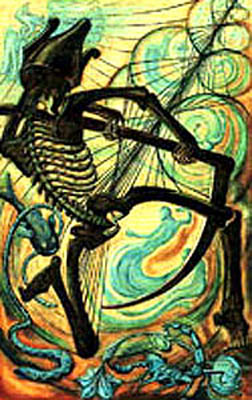
This card means redemption through putrefaction, the seed in the ground decays, but rises again to new life. Death, crowned with the headdress of Osiris, is raising from his scythe the reincarnating bubbles of life. Behind him is the eagle, symbol of immortality, and below him are the embryonic amœba.
XIV Art,
XIV Art. Temperance. Sagittarius. Samech
formerly called Temperance. The highest achievement of alchemy was the affecting of change, the transmuting of objects, qualities, colours and so on, into their opposites. Thus in this card the red lion has become white, the white eagle has become red. In the main figure, the black and white personages which were the Lovers in Card VI. are now interchanged and fused into an androgyne figure. This is the consummation of the Royal Marriage. The rainbow symbolises another stage in the alchemical process by the aura of many-coloured lights rising out of putrefaction. Putrefaction itself is shown by the raven perched on a skull on the cauldron. The consummation of the whole art of Alchemy is proclaimed in the glory with its inscription “visita interiora terrae rectificando invenies occultem lapidem.” The counsel to visit the interior of the earth is a recapitulation (on a higher plane) of the first formula of the Work. The important word is rectificando, it implies the right leading of the new living substance in the path of the True Will.
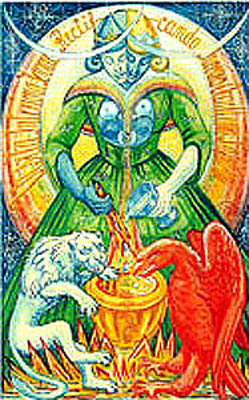
This is the second alchemical card, in which the Lovers are united in an androgyne figure, the Prince becoming white and the Princess black, the red lion white, the white eagle red and the cup is lighting the torch. There is a crucible engraved with a raven standing on a skull which holds the seething elements whose iridescent bubbles are reflected by the rainbow overhead. All these typify the destruction of two elements at the birth of a third. The inscription on the rainbow is the alchemical mandate “Visita interiora terrae rectificando invenies occultem lapidem.”
XV The Devil
XV The Devil. Capricornus. Ain
is here represented in the traditional form of the Goat. The cult of the Goat represents the impulse to reckless creation without any regard for result. Behind the Goat stands the Tree of Life, which pierces the Heavens in a medley of fantastic forms, recalling the markings on the planet Mars, always associated with the fiery material energy of creation. In the transparent roots the sap is seen, seething and leaping in every direction. The ring at the top is one of the rings of Saturn or Set, the Ass-headed god of the Egyptians. The spiral shape of the horns is an allusion to the highest and most remote things. Zoroaster defines God as “having a spiral force.”
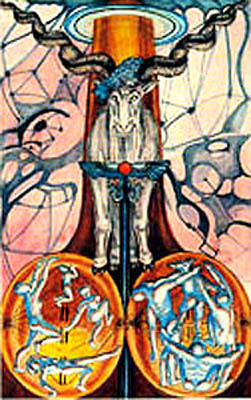
As this card is governed by Capricornus, we have the traditional goat. On his forehead is the Eye of God, his curved horns represent the spiral force in nature, that is wanton creation, and his abandonment is emphasized by the bacchanalian bunch of grapes. Beneath him are his votaries in two dividing cells, stressing the doctrine that all sin is division. The background is designed from the marking on the planet Mars. The Goat is supported on the Caduceus. At the top of the Tree of Life at the back of the card is the ring of Saturn.
XVI The Tower
XVI The Tower or Blasted Tower or the House of God. Mars. Peh
or the Blasted Tower, or the House of God. This card is attributed to the Hebrew letter Pé, which means a mouth. The card, which admits of two interpretations in one, is a manifestation in its rudest form, of pure destruction, the destruction of the old-established Aeon by lightning, flames, and engines of war. The other interpretation is drawn from the cult of Shiva. At the top of the card appears the Eye of Shiva. According to this, the card represents perfection, the perfection of annihilation by emancipation from the prison of organised life. The dove and the serpent represent the feminine and masculine impulses. In the language of Schopenhauer “The Will to Live and the Will to Die.”
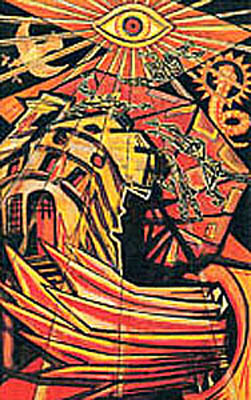
Here is purification through fire, lightning, flames, war. ‘The open mouth at the base of the card alludes to the Hebrew attribution Peh meaning a mouth, the eye is the Eye of Shiva. The card is designed on the form of a carbon crystal, the figures falling from the tower are made of carbon, the serpent on the right is the symbol of the active will to live, the dove on the left is passive resignation to death.
XVII The Star
XVII The Star. Aquarius. Daleth
Every form of energy in the card is spiral; this is in anticipation of the present Aeon, that of Horus, the crowned and conquering Child, successor to the “dying god,” Osiris. The departing Aeon is shown in the rectilinear forms of energy issuing from the lower cup. These forms stand for the now abandoned Euclidean geometry. The figure of the goddess may be taken as a manifestation of the surrounding space of Heaven.
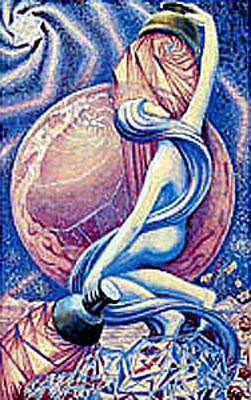
This is built up as a design on a spiral to show the rising force of a new age. The woman holds two cups, the north and south poles of magnetic attraction. Above her a new star is rising, beneath her are the crystallising dogmas of a former Age.
XVIII The Moon
XVIII The Moon. Pisces. Koph
This card represents the state of impure horror, hidden darkness which must be passed through before light can be reborn. The Moon is, therefore, the most universal of the planets, partaking at once of the highest and the lowest. At the bottom of the card moves the Sacred Beetle, bearing the Sun through the darkness of night. Above is the evil landscape of the Moon. A stream, or path of Serum, tinged with blood, flows between two barren mountains. On the hills are dark sinister towers. On the threshold stands the jackal-headed god, Anubis, in double form; at his feet are the jackals waiting to devour those who have fallen by the way.
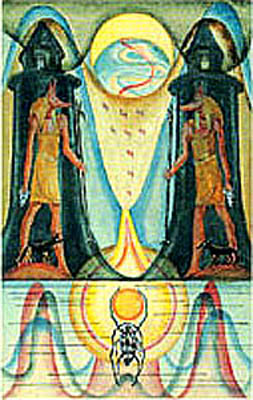
This is the most sinister card. Through sorcery and witchcraft it is possible to get an understanding of the universe, but the path is dangerous. On each side of the picture are dark fortresses, the Anubis the gods of death are ready to seize the soul of the aspirant. and jackals wait to devour those who have fallen by the way. The Sun is held by the Scarabeus Sacer under the water. The design on the card is planned on the movement of the tide whose ebb and flow is governed by the Moon.
XIX The Sun
XIX The Sun. Sun. Resh
This card represents the Lord of the new Aeon, the Lord of Light, Life, Liberty and Love, and the complete emancipation of the human race. The green mound represents the fertile earth, but the presence of a wall shows that the new Aeon does not mean the absence of control. The twin children are represented as dancing outside the wall, because they typify the new stage in human history, the stage of complete freedom from the restrictions imposed by such ideas as sin and death.
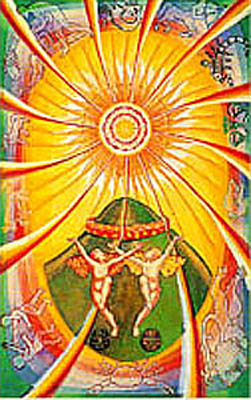
This card shows the simple human approach to the mysteries. The Sun is the lord of life, liberty, light and love. The children are dancing with butterfly wings. They are surrounded by the signs of the Zodiac, showing the different houses through which the Sun passes.
XX The Aeon,
XX The Aeon or Angel or Last Judgment. Fire. Shin
or the Angel, or the Last Judgment. The card is girt about with the body of Nuit, the star goddess, representing unlimited possibility. She surrounds the globe of fire, her mate, Hadit, standing for eternal energy. In the middle sits their child, Horus, also a solar deity, who is the incarnation of the New Aeon. The left hand, extended and empty, reminds us that the God has destroyed the old Universe, but is, as yet, too young to form its successor. At the bottom of the card appears the Hebrew letter, Shin, that is attributed to this card. The three Yods are occupied by three human figures arising to partake of the Essence of the New Aeon.
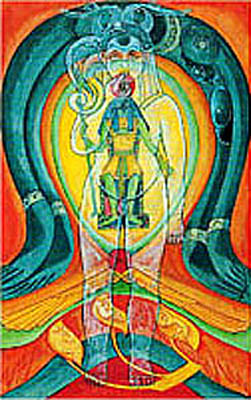
In the centre of the card is the child Horus, who is the incarnation of the New Age. His left hand is open, signifying that the old universe has been destroyed and he is too young to formulate a new one. He is surrounded by the figure of Nuit, the Star goddess, and beneath him is the winged point Hadit.
XXI The Universe
XXI The Universe. Saturn. Earth. Tau
This card is attributed to the letter Tau. Together with the first card, the Fool, the word Ath is spelled, meaning Essence. Thus all reality is comprised in the series of which these two cards are the beginning and the end. The letter Tau symbolises a fourfold extension, applicable to the transcendence of space and time by a continually self-compensating change. The letter is further attributed to Saturn, the slowest of the planets, and on that account associated with the element of Earth. Saturn is the old god, the god of fertility. The presence of the letter Tau upon the Tree of Life indicates a state of equilibrium between change and stability. The glyph on the card, therefore, symbolises the completion of the Great Work. The image of the Universe is a maiden, the final letter of Tetragrammaton. She is represented as dancing with the Great spiral-forming Serpent or Sun. She is surrounded by ten symbols. About her is an ellipse composed of seventy-two circles for the quinaries of the Zodiac. At the corners of the card are the four Kerubim, showing the established Universe. In the centre is the Wheel of Life, initiating the form of the Tree of Life, which is visible only to those of pure heart. On the lower part of the card is tho late J. W. N. Sullivan’s well-known map of the chemical elements.
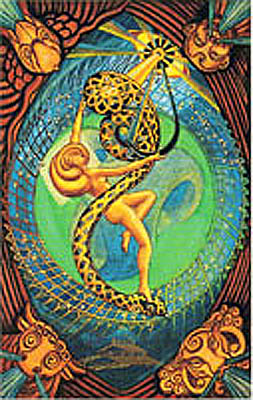
The universe is represented as a maiden dancing with a great spiral serpent. She holds the Moon in her hand and the Sun is merged in the Eye of God. These two planets typify the positive and negative forces. Behind her is a geometrical solid by Moebius. Around her are all the stars of the Zodiac, the curved seventy-two lines stand for the quinaries and are also an attempt to convey movement and to give the fourth dimension of time. Beneath her is Sullivan’s map of chemical elements. At the Four corners are the Cherubim or Winds of Heaven, the bull, the lion, the eagle and the man.
Jean-Pierre Laurant: Tarot
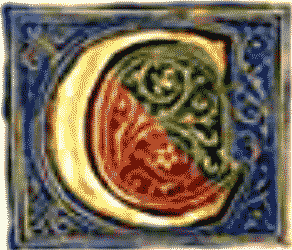 ard games in general and tarot cards in particular, like children’s and adult’ games, make a particularly strong appeal to the symbolic imagination. Whereas the standard pack of cards has been able to serve as a tool for divination mainly by combining the interpretation of signs with chance procedures, tarot cards have added to this function the desire to tap the secrets of the gods, by including a system of references and symbolic connections of an esoteric type, correlated with the planets and the cosmic hierarchies. The introduction of card games in Western culture can be traced back no further than to 1375 Florence, where Nicola della Tuccia (Chronicle of Viterbo, 1379) ascribed to them an Oriental origin under their initial name, naibe. However, all the images of these initial cards have been lost, and the same is true of the rules of the game. The cards that circulated in Germany and Italy around the beginning of the 15th century bore figures reflecting the culture and social problems of the time, and they multiplied rapidly thanks to the progress in the art of engraving; the “tarocchì” ascribed to Mantegna (1460) fall into this category. Given this context, the hypothesis according to which the tarot has an ancient Egyptian origin can be relegated to the realm of fiction. Moreover, the first elements of a divinatory and esoteric interpretation of the tarot do not seem to have appeared before the 18th century, particularly in France, after the number of cards and the figures on them had become sufficiently standardized.
ard games in general and tarot cards in particular, like children’s and adult’ games, make a particularly strong appeal to the symbolic imagination. Whereas the standard pack of cards has been able to serve as a tool for divination mainly by combining the interpretation of signs with chance procedures, tarot cards have added to this function the desire to tap the secrets of the gods, by including a system of references and symbolic connections of an esoteric type, correlated with the planets and the cosmic hierarchies. The introduction of card games in Western culture can be traced back no further than to 1375 Florence, where Nicola della Tuccia (Chronicle of Viterbo, 1379) ascribed to them an Oriental origin under their initial name, naibe. However, all the images of these initial cards have been lost, and the same is true of the rules of the game. The cards that circulated in Germany and Italy around the beginning of the 15th century bore figures reflecting the culture and social problems of the time, and they multiplied rapidly thanks to the progress in the art of engraving; the “tarocchì” ascribed to Mantegna (1460) fall into this category. Given this context, the hypothesis according to which the tarot has an ancient Egyptian origin can be relegated to the realm of fiction. Moreover, the first elements of a divinatory and esoteric interpretation of the tarot do not seem to have appeared before the 18th century, particularly in France, after the number of cards and the figures on them had become sufficiently standardized.
The so-called “Tarot of Marseille” (actually of Italian origin), around which Antoine Court de Gébelin formed his “Egyptian” interpretations in Le monde primitif (1781), has 22 cards, like all the other games. They are known as the “major arcana” or as “trumps” (derived from “triumphs”), and go from “Juggler” to “Fool”, with the “Emperor” and “Empress”, the “Hermit”, the “Pope”, the “Popess”, the “Hanged Man”, etc., in between. Each card carries an inscription, a sequential number, and more or less fixed colors in which blue and red predominate, though there are important variations from one game to the other. The Pope and the Popess are often replaced by Jupiter and Juno, the Juggler by the Magus, etc. The pack is completed by 56 common cards or minor arcana (53 in French games), divided into four suits: Swords, Cups, Wands (or Scepters), and Coins (or Pentacles), each numbered from 1 to 10 plus the court cards Page, Knight, Queen, and King. In English and French the game is called tarot; in German and Dutch Tarock or Tarok, derived from the Italian tarocchi; Spanish has retained a name close to the original, naipes.
Court de Gébelin, in the spirit of the Egyptomany of his time, attributed the paternity of the tarot to the god Thoth/Hermes, interpreting the game as a hidden text, a mutus liber (silent book) similar in nature to the Corpus Hermeticum. This hypothesis was circulated in the masonic community to which Court de Gébelin belonged, thanks to Alliette (Etteilla), a Parisian cartomancer and Grand Magus of the lodge of “The Perfect Initiates of Egypt”, who two years later published a Maniere de se récréer avec le jeu de cartes nommées tarots (Manner of Recreating Oneself with the Card Game Known as Tarot; see Bibliography). Alliette here revealed the true meaning of the game as a veritable synthesis of primordial knowledge, thanks to some modifications that he made of the figures. A secret society of the “Interpreters of the Book of Thoth” was founded in 1790.
It fell to the occultist Eliphas Lévi to construct the most complete system of tarot in his Dogme et rituel de la haute magie (1856), by making of divination the secret of secrets. His argument included a historical dimension, according to which the Ars Magna of Ramon Llull had actually been a cryptic commentary on the tarot. The decisive argument, for Lévi, was provided by Guillaume Postel, whose Clef des choses cachées depuis la constitution du monde (Key to Things Hidden since the Constitution of the World, 1546) contained an illustration of a key ornamented with geometric designs and accompanied by an inscription that could be read as ROTA in one direction and TARO in the other. These were two quite arbitrary interpretations, especially since the passage of Postel concerns an interpolation in the Franckenberg edition (Amsterdam 1646). Lévi adopted Alliette’s assertions wholesale, but relativized them by claiming that while Alliette had presented the truth, he, Lévi, had finally unveiled it by re-establishing the symbolic correspondences in their precise meaning. ‘The tarot, this miraculous book, inspiration of all the sacred books of the ancient peoples, is, because of the analogical precision of its figures and numbers, the most perfect instrument of divination, which can be used with complete confidence’ (Dogme et rituel de la haute magie, vol. 1, ch. 10). In a later work, La clef des grands mystères, Lévi analyzed the symbolism of numbers with reference to the cards, but for unknown reasons stopped at 19, although stating that the sacred language (Hebrew) had 22 letters. The occultists followed in Lévi’s footsteps. Stanislas de Guaïta planned his series of works forming Le serpent de la Genèse (1891-1897) in three volumes – I. Le temple de Satan, II. La clef de la magie noire, III. Le problème du mal – with seven chapters in each volume in the order of the cards (the 22nd, the World, serving as a conclusion). Guaïta was preceded by Paul Christian (ps. of Christian Pitois) in L’Homme rouge des Tuileries (The Red Man of the Tuileries; 1863). Papus (Gérard Encausse), brilliant popularizer of the great themes of fin de siècle occultism, followed with many references scattered throughout his oeuvre and two entire works dedicated to an interpretive synthesis: Le tarot des Bohémiens (The Tarot of the Bohemians/Gypsies, 1889, reissued in 1911) and Le tarot divinatoire (The Divinatory Tarot, 1909). He reworked and classified the labors of his predecessors, stressing the cryptic aspect of this primordial revelation: a veritable Bible for the “Bohemians” and preserved in popular traditions, albeit confusing good and evil, the fall and “reintegration” of man. The concordance with the Archéomètre (1910) of Saint-Yves d’Alveydre, who had supposedly reconstituted the primordial language, showed that the universal key to symbolism could indeed be found in the secrets of the tarot. Some Freemasons were also concerned with the interpretation of the game; one example is Oswald Wirth (1860-1943), former secretary to Guaïta and renovator of the symbolism of French Freemasonry, who published Le tarot des imagiers du Moyen Age (The Tarot of the Medieval Artists) in 1926. These speculations crossed the English Channel at the end of the 19th century with Arthur Waite, a disciple of Lévi who published The Pictorial Key to the Tarot in 1910, while in 1913 P. D. Ouspensky published another study of its symbolism as a “model of the universe”, in the light of oriental religions and of Carl Gustav Jung’s depth psychology. The occultist and paramasonic society of the Hermetic Order of the Golden Dawn played a large role here; the notes of one of its founders, MacGregor Mathers, were collected by Israel Regardie in a Golden Dawn Tarot. But it was above all Aleister Crowley, one of its most conspicuous members, who systematically integrated the tarot in his magical and masonic speculations, with the help of astrology and the kabbalah. In Magick in Theory and Practice (1930) and The Book of Thoth (1944), Crowley changed the names of the major arcana and interpreted the trumps as hieroglyphs charged with universal energy. His tarot and that of Waite published by Rider are the most widespread in the English-speaking world, and are constantly reprinted.
— Jean-Pierre Laurant in: Wouter J. Hanegraaff: Dictionary of Gnosis and Western Esotericism. Leiden: Brill, 2006. pp. 1110-1111.
